When I was a kid back in Ukraine, my family and I lived in a communal apartment – a kommunalka, as it was called. This phenomenon was a response to the housing crisis of 1900’s Soviet Union. One communal apartment could house two or more entire – often multi-generational – families. Each family would be given a room, which would serve as their bedroom-slash-living room. The entryway, kitchen, and bathroom would be shared by everyone in the apartment, and all the rooms were connected by long, dimly-lit corridors. You can think of it like a college dorm, but way less fun.
How anyone ever procreated is beyond me.
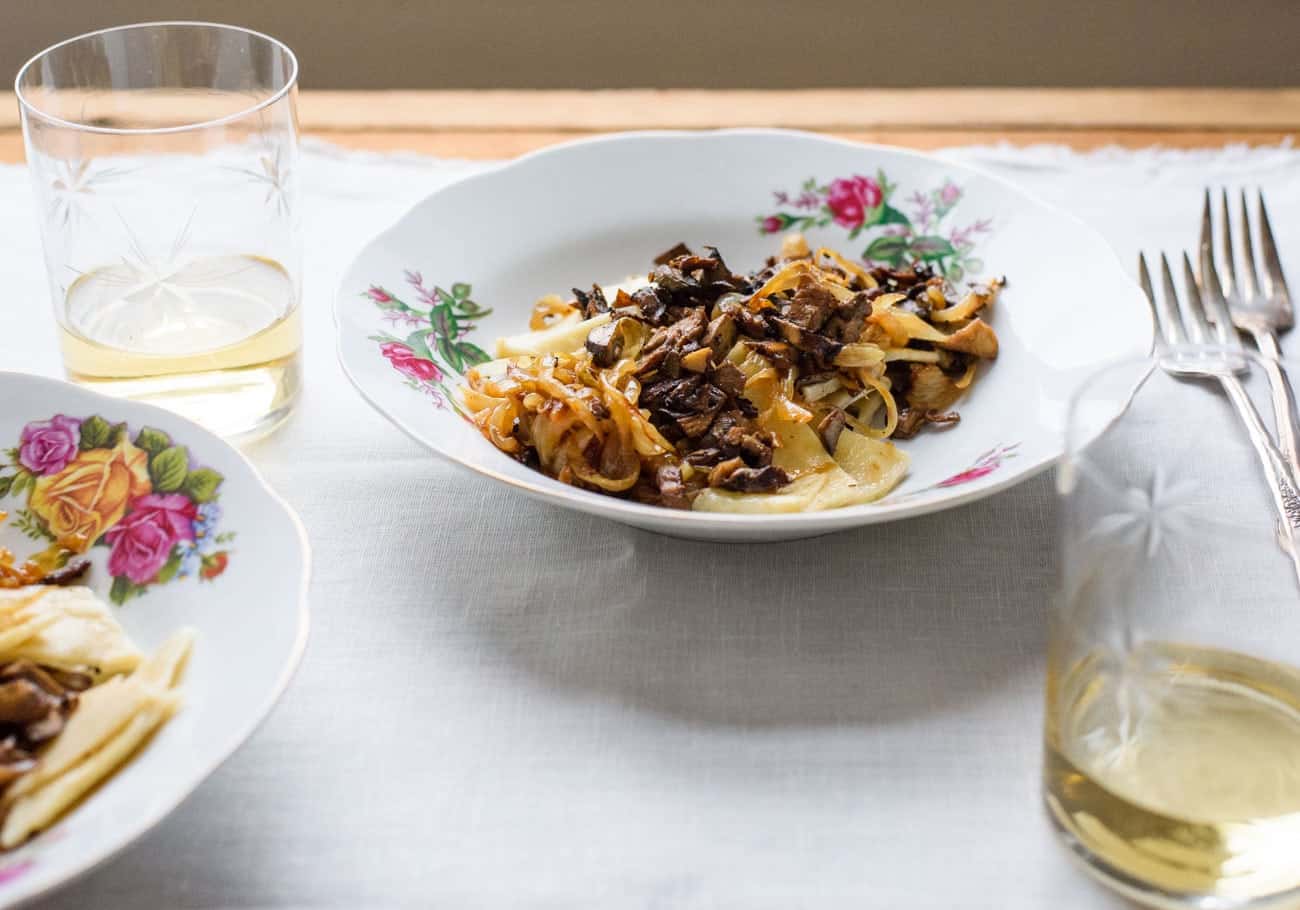
By these standards, we were lucky. Our communal apartment had three whole – albeit connected – rooms and we had only one other family with whom to share our front door. Each of us also had our own kitchen! Very lucky indeed.
When I was about 5, an Armenian family moved into our communal apartment. Like us, they were a mom, dad, and two daughters. Although it was undoubtedly difficult to raise a family in such small quarters, neither my parents nor our neighbors ever showed it. My mom quickly found a confidante in the matriarch across the wall, and my sister and I were thrilled to have two new best friends.
The six of us would often eat lunch together and I still remember how exotic and exciting their food seemed to me. The weirdest thing was the lavash, a paper-thin flatbread our neighbors ate with every meal (the first time I saw it, I thought it was a napkin and tried to wipe my hands with it). Eventually I learned to wrap prickly cucumbers and briny feta in it, which made a great snack.
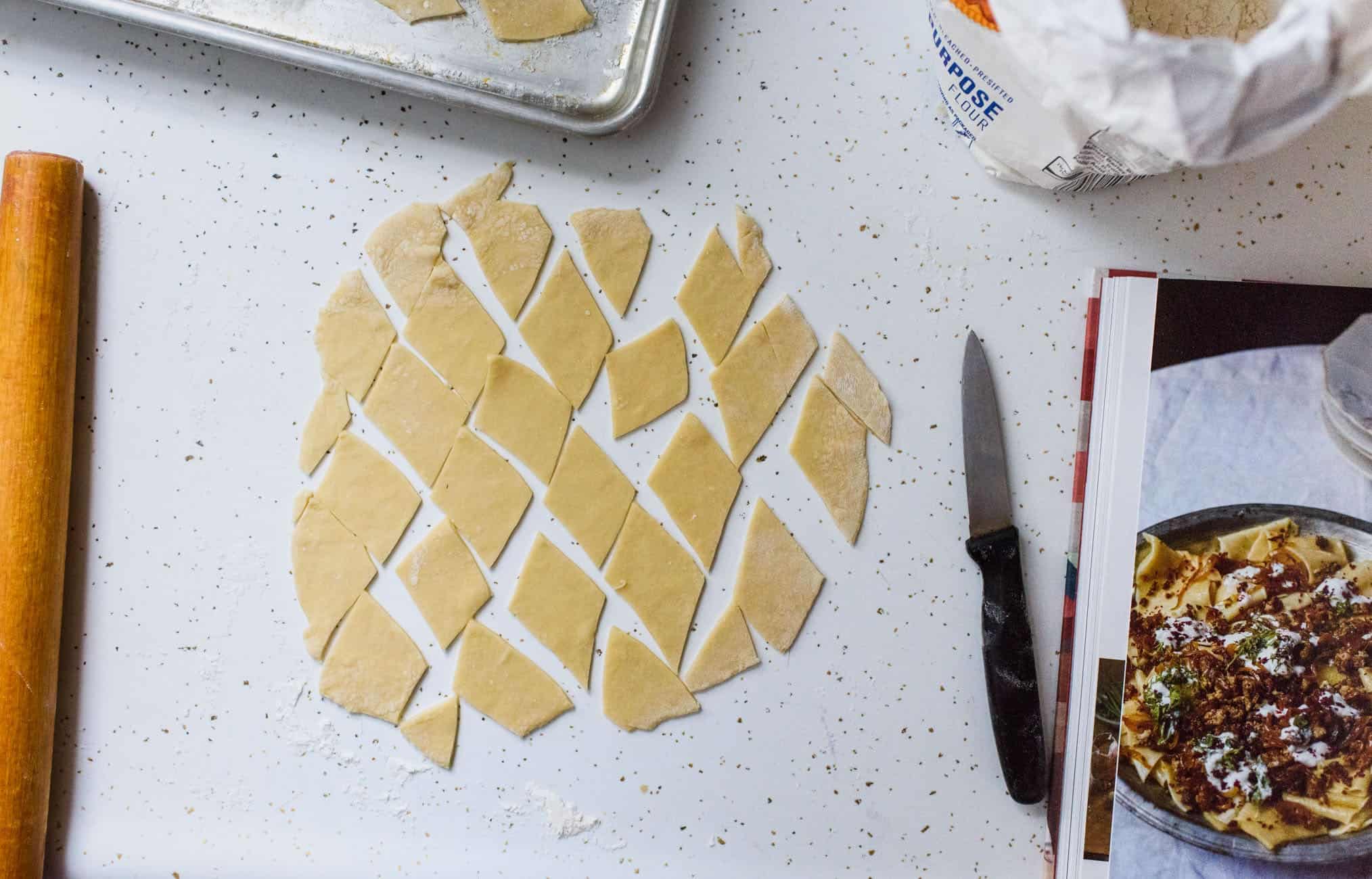
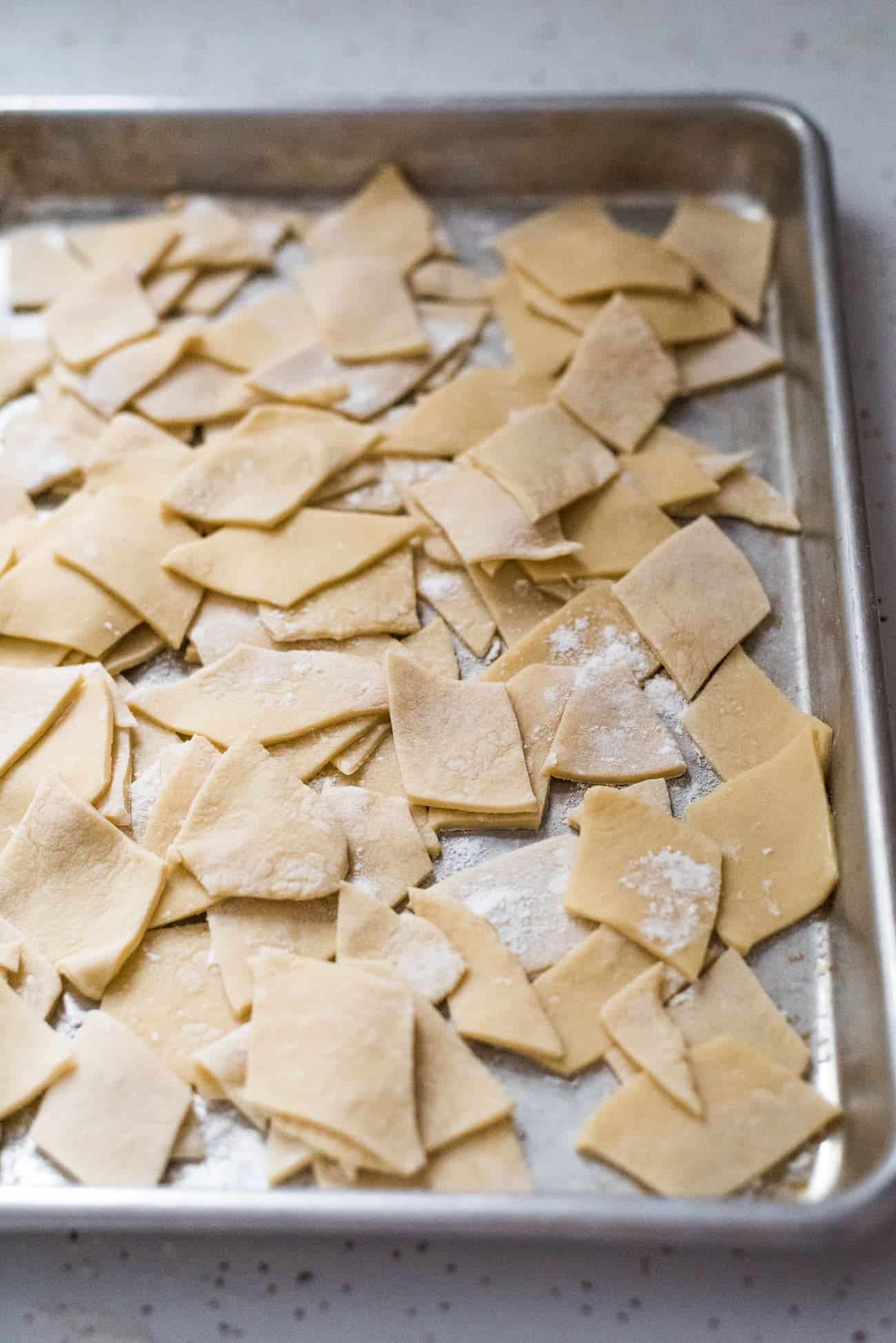
My favorite thing that Rimma treated us to were these slippery homemade noodles cut into diamond shapes, which we ate with a cool, garlicky dill yogurt sauce. They were chewy, thick, and wildly addictive. Although I hadn’t had the noodles since then, I never forgot them.
Fast forward to this winter, when a copy of Olia Hercules’s second cookbook arrived at my doorstep. Those of you who’ve been longtime readers may remember me writing about her debut volume, Mamushka, an ode to traditional Ukrainian cuisine, in 2016. This time around, Olia is tackling the Central Asian region of Caucasus – namely, Georgian, Armenian, and Azerbaijani cuisine. I couldn’t wait to dive into Kaukasis, since the food of this region is even lesser known than Ukraine’s. Even to me.
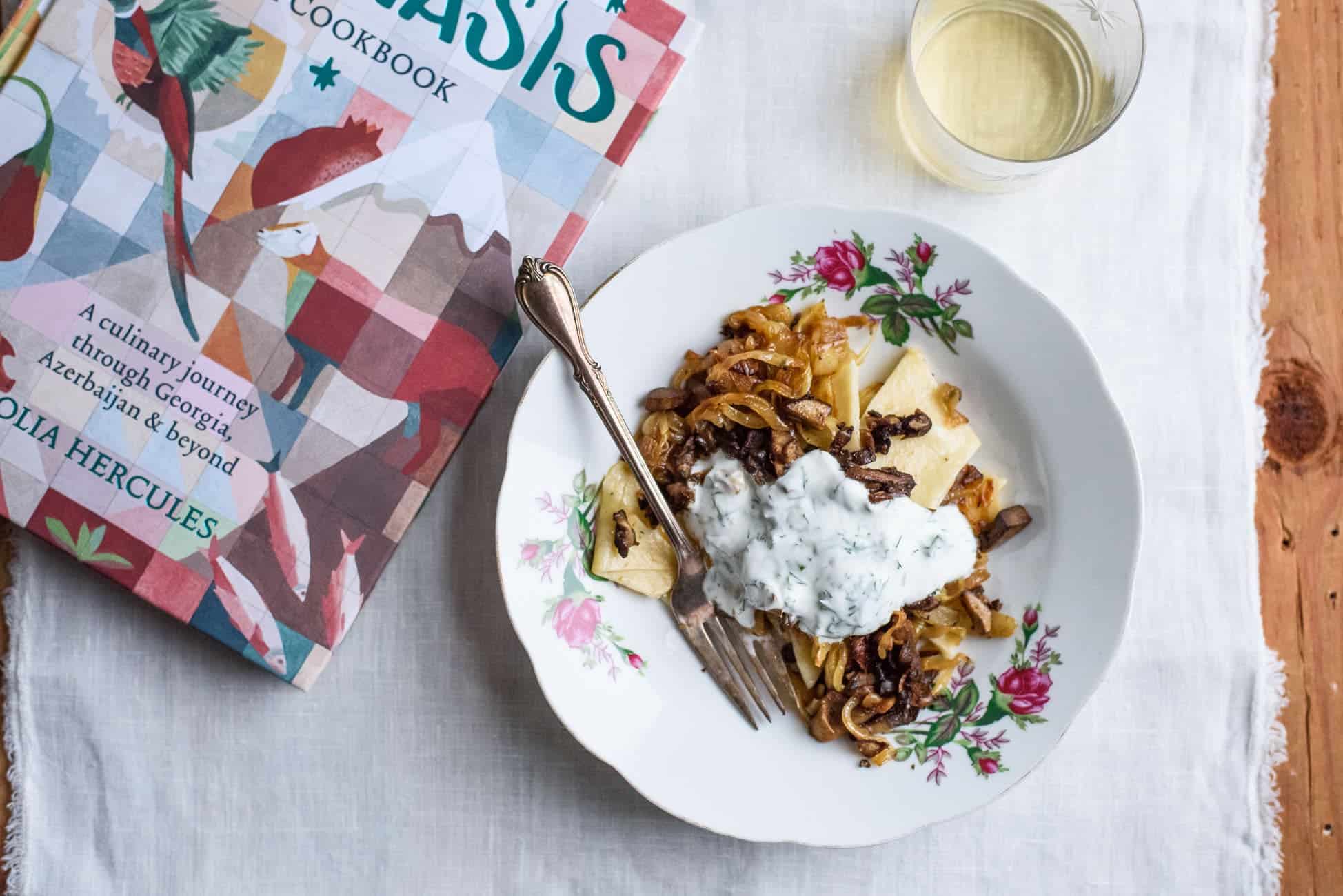
Kaukasis achieves something few cookbooks succeed at: it transports you into a different world. The stories, the photos, the recipes… you actually feel as though you’re on this journey with Olia, guided by her warm, curious voice. Speaking of which, Olia has the most amazing accent – a British-Ukrainian hybrid – as well as some great stories, which I encourage you to hear on both Milk Street Radio and Radio Cherry Bombe.
As I cracked open the book, I immediately landed on the recipe for Khingal – my beloved noodles! Olia cites the recipe’s origin as Azerbaijani cuisine, not Armenian. The noodles in the book are also topped with browned onions and ground lamb, which I don’t remember from my childhood. I decided to switch the lamb for mushrooms, since we don’t eat much meat at home.
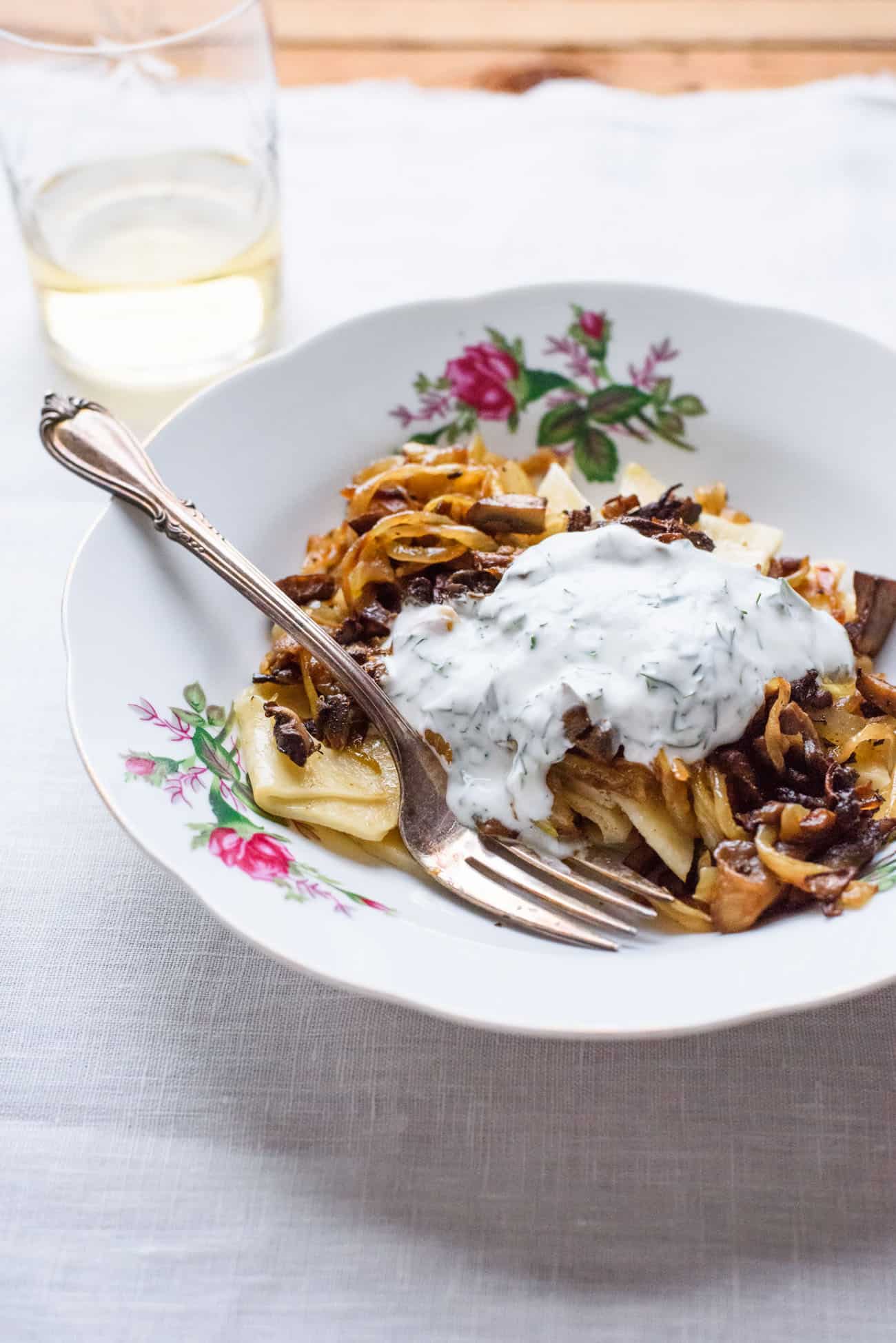
This pasta is exquisite. Bite after chewy bite, you don’t tire of the flavors of sweet onions, spiced mushrooms, and herby yogurt mingling with each other in your mouth. It’s so satisfying, yet so simple. No sous vide, 12-hour braising, shaved truffles, or lobster tails here. Just noodles, onions, mushrooms, yogurt, and herbs – the commonest, humblest of ingredients. I’ve never compared food to sex before but in this case, I can’t not. And I don’t mean the regular Wednesday night kind. I mean that first time with someone you really like and think may be the One; I mean Ross and Rachel getting back together for the third time; I mean the kind where everyone’s left the kommunalka and you finally get to be alone together.
Khingal is also super easy to make, since the noodles are hand-cut and don’t require a pasta machine. All you need is a little patience for kneading. And a disclaimer: I realize that between the white flour and yogurt this recipe isn’t exactly “plant-based whole foods”-friendly, but when you re-discover your favorite food from the motherland, you can’t not share it on your blog.
Print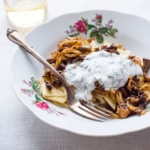
Azerbaijani Khingal (Handmade Noodles with Mushrooms and Yogurt Sauce)
- Prep Time: 40 mins
- Cook Time: 30 mins
- Total Time: 1 hour 10 minutes
- Yield: 4 servings 1x
- Category: Dinner
- Cuisine: Azerbaijani
Description
These chewy handmade noodles belong to traditional Azerbaijani cuisine. Typically served with browned ground lamb, this vegetarian version calls for mushrooms.
Ingredients
For the Dough:
- 1 large egg
- 1/4 cup water
- 3/4 teaspoon salt
- About 1 2/3 cups all-purpose flour, plus extra for kneading
For the Toppings:
- 3 tablespoons extra virgin olive oil, divided
- 2 tablespoons butter, divided
- 3 small yellow onions, sliced
- 1/2 teaspoon salt, divided
- 10 ounces mixed mushrooms (I used shiitake, cremini, and oyster), finely chopped
- 1/2 teaspoon ground cumin
- Freshly ground black pepper to taste
- 1/2 teaspoon sumac, to serve (optional)
For the Yogurt Sauce:
- 3/4 cup plain full fat yogurt (grass-fed, if possible) OR unsweetened non-dairy yogurt
- 1 medium garlic clove, grated
- 1 tablespoon minced dill
- 1 tablespoon minced cilantro
- Salt to taste
Instructions
- Make the dough. In a large bowl, whisk together the egg, water, and salt. Begin gradually adding the flour (stop if the mixture is getting too dry) and stirring the mixture with a spoon – when it gets too thick, switch to your hands. Turn the dough out onto a lightly floured surface and knead it for about 5 minutes, making quarter-turns as you go. You should end up with a firm, elastic dough that doesn’t stick to your hands. If it’s sticky, add a bit more flour. Wrap the dough in plastic and refrigerate for 15-30 minutes.
- Preheat the oven on a low setting to keep the toppings warm later on, if desired. I personally don’t mind the onions and mushrooms at room temp.
- Make the toppings. In a large non-stick skillet, heat 1 tablespoon oil and 1 tablespoon butter over medium-low heat. Add the onions with 1/4 teaspoon salt and cook, stirring frequently, until they are soft and caramelized, about 20 minutes. Transfer to a bowl and set aside, or transfer to an oven-safe dish and keep warm in the oven.
- Add the remaining 2 tablespoons of oil to the skillet and increase the heat to medium. Add the mushrooms, cumin, 1/4 teaspoon salt, and pepper. Cook, stirring occasionally, until the mushrooms are nicely browned, about 7 minutes. Set aside.
- Bring a large pot of water to a boil.
- Remove the dough from the fridge and let it come to room temp while you make the sauce.
- Combine the yogurt, garlic, dill, and cilantro in a bowl. The sauce should be thick but pourable. Stir in a bit of water to achieve this consistency, if needed. Taste and season with salt.
- Cut the dough into 4 pieces and roll them into balls. Using a rolling pin, working with 1 ball at a time, roll out the dough to about a 1/16-inch thickness – it should be slightly thicker than pappardelle, as you want the noodles to have a chewy bite. Slice the dough into diamond-shaped noodles and transfer to a lightly floured baking sheet or tray. Repeat with the remaining dough.
- Season the boiling water generously with salt. Lower the noodles into the pot and stir gently to prevent them from sticking to the bottom. When they float up to the top and the water starts rapidly boiling again, they are done – this takes 2 minutes.
- Drain the noodles and transfer to a serving platter. Toss with the remaining tablespoon of butter and top with the onions and mushrooms. Sprinkle with sumac if using and black pepper. Serve immediately, with the yogurt sauce.
Notes
The book states the recipe should serve 8. In my household, it serves 4… although to be honest, Rene and I have finished the entire platter together in 1 sitting.
Nutrition
- Serving Size: 1/4 of the recipe
- Calories: 413
- Fiber: 3.3 g
- Protein: 11.4 g

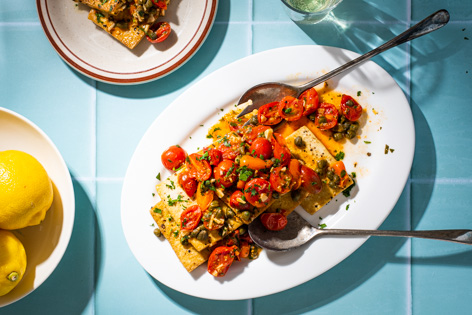
Leave a Comment